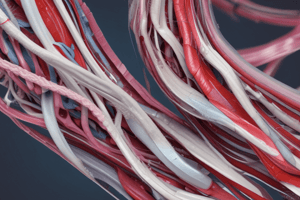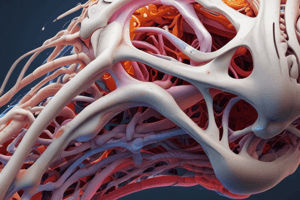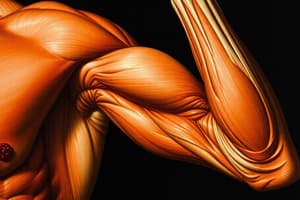Podcast
Questions and Answers
What should you always watch out for in tissue biomechanics?
What should you always watch out for in tissue biomechanics?
tensor/vector notation
According to the summary, what structure should you learn about in tissue biomechanics?
According to the summary, what structure should you learn about in tissue biomechanics?
Muscle/Tendon/Cartilage/Blood Vessel Structure
How do the Radial/Circumferential stress change with the radius?
How do the Radial/Circumferential stress change with the radius?
decreases with the radius
What is the nature of residual stresses at the inner and outer layers?
What is the nature of residual stresses at the inner and outer layers?
What effect does the residual stress have on the circumferential stress?
What effect does the residual stress have on the circumferential stress?
What is the purpose of the summary according to the preface?
What is the purpose of the summary according to the preface?
What type of equations will be provided on the exam?
What type of equations will be provided on the exam?
What is the purpose of not printing the summaries?
What is the purpose of not printing the summaries?
What was discussed in Lecture 2-5?
What was discussed in Lecture 2-5?
What were the main topics covered in the lecture on Bone Mechanics?
What were the main topics covered in the lecture on Bone Mechanics?
What did Lecture 7-8 focus on?
What did Lecture 7-8 focus on?
What were the types of connective tissue discussed in Lecture 10?
What were the types of connective tissue discussed in Lecture 10?
What were the main topics covered in the lecture on Muscle Mechanics?
What were the main topics covered in the lecture on Muscle Mechanics?
What was discussed in Lecture 14?
What was discussed in Lecture 14?
What was the focus of Appendix A?
What was the focus of Appendix A?
What were the topics discussed in the Introduction Lecture?
What were the topics discussed in the Introduction Lecture?
In tissue biomechanics, what is the effect of residual stress on the circumferential stress?
In tissue biomechanics, what is the effect of residual stress on the circumferential stress?
What is the nature of residual stresses at the inner and outer layers in tissue biomechanics?
What is the nature of residual stresses at the inner and outer layers in tissue biomechanics?
According to the summary, what should be watched out for in tissue biomechanics?
According to the summary, what should be watched out for in tissue biomechanics?
What should be learned about in tissue biomechanics according to the summary?
What should be learned about in tissue biomechanics according to the summary?
What is a key aspect to remember when studying for the BM41131 Tissue Biomechanics Exam according to the preface of the summary?
What is a key aspect to remember when studying for the BM41131 Tissue Biomechanics Exam according to the preface of the summary?
What is not present in the summary according to the preface?
What is not present in the summary according to the preface?
What is the purpose of not printing the summaries according to the preface?
What is the purpose of not printing the summaries according to the preface?
What did Lecture 7-8 focus on?
What did Lecture 7-8 focus on?
According to the summary, what structure should you learn about in tissue biomechanics?
According to the summary, what structure should you learn about in tissue biomechanics?
What is the effect of residual stress on the circumferential stress in tissue biomechanics?
What is the effect of residual stress on the circumferential stress in tissue biomechanics?
What were the main topics covered in the lecture on Bone Mechanics?
What were the main topics covered in the lecture on Bone Mechanics?
What was discussed in Lecture 2-5?
What was discussed in Lecture 2-5?
What were the types of connective tissue discussed in Lecture 10?
What were the types of connective tissue discussed in Lecture 10?
What is a key aspect to remember when studying for the BM41131 Tissue Biomechanics Exam according to the preface of the summary?
What is a key aspect to remember when studying for the BM41131 Tissue Biomechanics Exam according to the preface of the summary?
"What is continuum mechanics?"
"What is continuum mechanics?"
What is an important characteristic about tissue behavior that was discussed regarding tissue structure in Lecture 1?
What is an important characteristic about tissue behavior that was discussed regarding tissue structure in Lecture 1?
Flashcards are hidden until you start studying
Study Notes
Tissue Biomechanics
- Always watch out for residual stress and structure in tissue biomechanics.
- Learn about the structure of blood vessels in tissue biomechanics.
Stress and Radius
- Radial/Circumferential stress changes with the radius.
- Residual stresses are compressive at the inner layer and tensile at the outer layer.
Residual Stress Effect
- Residual stress decreases circumferential stress.
Exam and Summary
- The purpose of the summary is to help prepare for the BM41131 Tissue Biomechanics Exam.
- No equations will be provided on the exam.
- Summaries are not printed to encourage active recall.
Lecture Overview
- Lecture 2-5: Not specified
- Lecture on Bone Mechanics: Covered bone structure, function, and biomechanics
- Lecture 7-8: Covered soft tissue biomechanics
- Lecture 10: Covered types of connective tissue
- Lecture 14: Not specified
- Appendix A: Focus on continuum mechanics
- Introduction Lecture: Introduced the concept of tissue biomechanics
Important Concepts
- Continuum mechanics is an important concept in tissue biomechanics.
- Tissue behavior: Non-linear, heterogeneous, and anisotropic, which was discussed in Lecture 1.
Studying That Suits You
Use AI to generate personalized quizzes and flashcards to suit your learning preferences.




